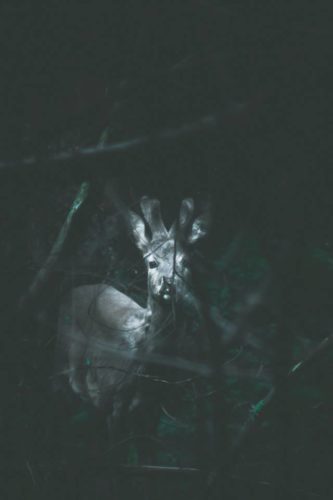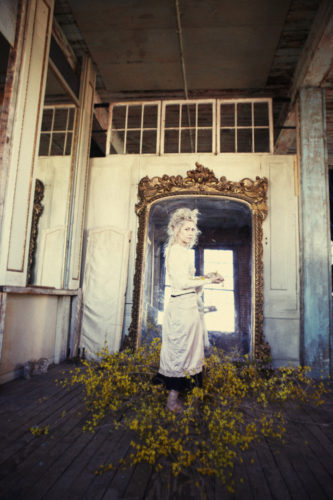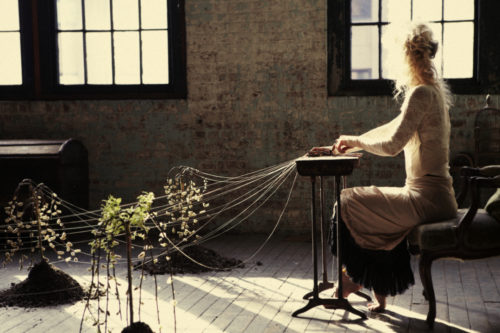Katie Cercone: Really excited about your upcoming Dream Tending workshop. I have heard that you can follow your initial impulse when it comes to interpreting a dream, although I also believe our dreams dredge up unconscious shadow work we don’t want to look at. In that sense, our ego could be obscuring the truth in our initial reading of the dream content. What’s your philosophy? Do you subscribe to a set of symbols and meanings in terms of your Dream Tending framework?
Julia Frodahl: There are many different kinds of dreams. There are precognitive dreams, medicinal dreams, personal mythology dreams, dreams that show us we’re on the right track, or the wrong track, and yes, dreams that are part of our shadow work where aspects of ourselves that we discarded for one reason or another lie waiting to be loved and reclaimed. Waiting to be brought back into the field of wholeness in a healthier way. The Dream Tending that I teach is a little different than more traditional dream analysis in that it invites us to work with the dream from a more dreamlike state. More as participants than as detectives. Under the blade of our more analytical minds, we can indeed be limited by the biases of what we want to see or don’t want to see. We can also miss the important subtleties and sentiments of the dream. But when we enter the dream more as a dreamer, and speak in the language of the dream, when we court the characters the way we do in dream tending, rather than investigate them, the deep, true, beautiful meaning of our dreams is more likely to emerge. Like living beings, dream characters tend to reveal their deeper layers when regarded in a field of openness, patience, and acceptance. In terms of symbols and meanings, the majority of characters and images that appear in our dreams hold a meaning that’s unique to the dreamer. Only a few are archetypal and there are ways to know when an image is personal or archetypal, which we’ll discuss more in the course in January.
Cercone: You mentioned how Dream Tending is ideal for artists because it provides “easier access to the unending flow of creation/creativity in the individual unconscious and beyond,” and creates the ability to “bypass rational boundaries.” Often, as artists, we are so tried for time and money, like the one that can be earned on 카지노사이트 , that we overwork ourselves into a state of decline and derangement. I’ve found that time, alternatively invested in self-care, internal-work and spiritual practice, ultimately gives us more time in the day to do our soul purpose and respond creatively in the moment. Spiritual growth shifts our relationship to time altogether. Can you talk about the necessity of self-care for creative people in such a brutal economy and how this relates to your Inner Work?
Frodahl: Yes, it’s a brutal economy and social climate for artists right now. But investing time and sometimes other resources into self-care (body and spirit) is the best investment you can make. When the inner and outer self is cared for, everything runs more smoothly. Problems are more easily averted, solutions are more easily found, ideas and creativity flow more freely. This fluidity means more time and energy for your soul purpose, and a greater likelihood of manifesting what you need in the material world in order to support your work.
In taking care of ourselves, we send our deep-self the message that we deserve to be happy and well, and that we’re worthy of love and good things. That alone helps manifest a material experience that reflects this back to you. The thing to remember is that all form comes from the formless (dreams, thoughts, feelings, beliefs). And though you’re not the only person dreaming up our shared existence, including the brutal economy, you are the most powerful dreamer in the creation of your individual life. So it’s time well spent to be working at the level of dreams, thoughts, feelings, and beliefs — while simultaneously working on the material level — to create a life that you will enjoy and a life that will help bring out your creative gifts.
Going tenderly and honestly into the many layers of a person’s dreams, thoughts, feelings, and beliefs is part of what I do in my private Inner Work practice. There are ways we can make deep and lasting changes there that set a person free. Inner Work helps us get into a healthier relationship with all aspects of ourselves, even the difficult aspects, which is a kind of training that allows us to be in a healthier relationship with all those around us as well. This harmony that starts at the center of you has an abundant effect on life in general. And if that harmony is allowed to continue expanding, it ultimately has the power to free us from the greater, collective illusion of scarcity.
Cercone: I’ve been to some of your classes and even a yoga retreat upstate. As a seasoned yogi of over 20 years who is also a mentor, mindfulness advocate and healer, you’ve talked about how meditation and yoga tend to stimulate more dreaming and dream recall. I’ve heard of an age-old practice within Tibetan Buddhism called “Dream Yoga,” which is based in the notion that we aren’t falling asleep each night but are practicing “waking up,” and that we are actually sleep-walking through life (until we become Awakened through the practice). I know you draw from Buddhist teachings in your work. Can you talk a little bit about the connections here, and how you have reinvented some of these notions for your work within a contemporary, Western framework and also incorporated Jungian and Process-Oriented psychology?
Frodahl: That’s a beautiful way of looking at things. In my view, the seen (waking life) and the unseen (the dream realm) are two halves of an unfolding conversation. A conversation that has to do with consciousness. One dimension is formless and the other has form, but both are equally real. You know, the original symbolic meaning of the cross — in Christianity, Judaism, Paganism, and pretty much every other religion that uses it — was the idea that matter crossed with spirit creates soul. I think part of our work here is to learn to value both the seen and the unseen, matter and spirit, equally. This runs parallel to the work we have to do in valuing both the feminine and the masculine equally. Our souls thrive where spirit and matter meet. Where the seen and the unseen converge. The idea is to live right at the crux where matter and spirit meet. To not value one and judge the other, but to see both as complimentary halves that together are creating consciousness.
Arny Mindell, the founder of Process-Oriented psychology and one of my teachers, has devoted his life to showing the connection between psychology, shamanism, and quantum physics. It may be too complex to unpack here, but one basic idea is that the dream realm is the basis of our daily lives in much the same way the quantum level is to matter. I am so grateful for his work and draw from it quite a bit in helping people see the relationship between realms. Buddhist practices are also helpful because they de-clutter the mind, help us unhook where we get caught, and help us see past illusions to the ultimate truths. These ideas and methods can work together to make our material lives into lives that have more sacredness and grace to them. They can help us more consciously visit the dream realm and carry it inside of us as we walk in the light of day.
Cercone: You wrote “We’ve fallen out of the dialogue between the seen and the unseen and find ourselves lost in an unfulfilling, wayward monologue in the material realm.” Which is to say, the more we get caught up in our story or monologue, the more we feel disconnected and the less access we have to, as you call it, “the dream realm where everything begins.” Meanwhile, our dream life is manifesting itself in our physical reality including our relationships, decisions, urges, feelings, and bodily symptoms. Can you talk more about how everything begins in the dream world and what this means? And have you found that your clients have healed physical symptoms with Dream Tending?
Frodahl: Through Dream Tending, and usually coupled with other aspects of inner work, yes, I’ve had many students who’ve remedied physical symptoms and ailments. I’ve seen remarkable reductions in anxiety and depression. I’ve seen nightmares that had been recurring for years come to an end after working with the dream characters. I’ve had students release addictions through Dream Tending. I’ve had a person with an inexplicable shortness of breath return to normal breathing after working with her dreams. These are just a few examples. Our unacknowledged feelings often show up as body symptoms and in our dreams. We can often remedy the symptoms by getting to the feelings that the dream is helping us see. That said, if you have symptoms on the material level, it’s important to also take care of them on the material level. It’s always best to work on both levels, especially if something is already in a manifested state.
Cercone: What is your relationship to the Internet like given how successfully you’ve been able to build your work online, including the new set of online courses and your impressive following on Instagram. Do you limit time spent with social media? How can we commit to regular digital detox and mediating the empty escapism and outward-seeking that can so often be a by-product of virtual spaces?
Frodahl: I think escapism and outward seeking is replaced when we rediscover that the portal to real fulfillment and love is within. When we remember that, we simply cease looking in the places they can’t be found — places such as social media and endless news feeds. Not only does social media not provide the fulfillment we seek, it’s an addictive distraction that inhibits us from accessing it elsewhere. Dream Tending is truly a beautiful road back in. The more you learn the language of dreams, and the more you discover what a creative masterpiece every dream is, the more you’ll fall back in love with this magical, mysterious experience we’re living in. Once you’re back in touch with the mysterium, and once you know where to find things of substance, you won’t reach for the things that make you feel empty.
I use the Internet as a way to reach the people I’m aligned to, and it allows me to do that without the limitations of physical location. Through these courses, I can also use the Internet to help bring like-minded people into contact with one another. People who would otherwise have a hard time finding one another. A lot of the people I work with are looking for a deeper connection, and long for a community of others who are kind-hearted, reflective, and spiritual in a non-dogmatic way. Here, they will find that. And in addition to learning the art of Dream Tending, people who join the course will have a community of kindred spirits to stay in touch with and dream with well into the future if they want to.
Cercone: Nature seems to be an overarching factor in your work, including the Nature-based Maps of the Psyche you are known for, and yet most of us today don’t live in nature-based communities. Where does the element of paradox play into our contemporary relationship to nature and the spiritual? How do we make room for nature in our lives at a healthy pace and in simple ways that can transform our modern lives?
Frodahl: I suggest thinking of nature in greater way. Some of us may not live immersed in wild nature with beautiful sweeping green landscapes or breathtaking deserts. Maybe we live in a concrete city. But we are nature. We are soft bodies. We are all subject to nature’s laws about cycles and impermanence. We have the four directions. We have the elements. We have the immense sky above us. And dreams are nature as well, pushing Her way through us, bypassing the logical mind the same way a shoot of green pushes itself through a crack in the sidewalk.
Start there. And you’ll remember that we’re not machines, but rather we’re living participants in an extraordinary, elaborate, ever-unfolding miracle. That is nature.
Follow her on instagram @juliafrodahl
Learn more at http://juliafrodahl.com/











